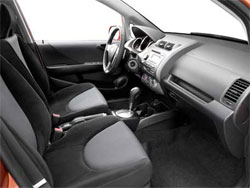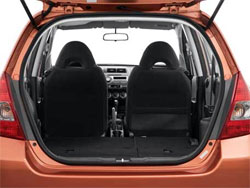2007 Honda Fit
As soon as gas prices breached three bucks a gallon last fall, the hue and cry went up for automakers to build more small, fuel efficient cars. Despite the fact that history tells us this demand deflates as soon as prices fall, automakers are responding with a host of new subcompacts. We’ve already tested the Toyota Yaris. This week we try the Honda Fit. The Fit is everything anyone could want in a small car. It’s stylish, roomy, and frugal. But is the Fit still a good fit for America?
Honda is a company driven by engineering. So even an economical, entry-level subcompact like the 2007 Fit is bound to be more than just a fuel-sipping engine wrapped in a tiny body. Not that the 5-door hatchback Fit isn’t small. Wheelbase is a compact 96.5 inches and the overall length is only 157.4 inches. That’s almost 20 inches shorter than a Honda Civic sedan.
But while it doesn’t take up much pavement, the Fit’s unusually tall cabin yields an impressive passenger volume of 90.1 cubic-feet, or just a hair less than a 4-door Civic.
 And the Fit measures up big in other areas as well. Its airy interior boasts a typically efficient, driver-oriented Honda dash. But it’s also stylish with high-grade plastics and precise controls. The Fit’s top drawer level of standard safety features includes front side impact and side curtain airbags.
And the Fit measures up big in other areas as well. Its airy interior boasts a typically efficient, driver-oriented Honda dash. But it’s also stylish with high-grade plastics and precise controls. The Fit’s top drawer level of standard safety features includes front side impact and side curtain airbags.
As the best equipped car in its small class, Fit also includes a CD stereo. Our Sport-grade test car upgrades to 160-watt power that plays MP3 and Windows Media, has an auxiliary audio input jack, and speed-sensitive volume control. Air conditioning is also standard, as are power windows and locks, plus a tilt steering wheel, which helps you find the most comfortable position in one of the Fit’s few major shortcomings; the front seats. The cloth upholstery doesn’t seem very durable and they need more lower back and thigh support.
The split rear bench seat is also a bit too flat and firm. But its clever design and easy access through oversized doors is Fit’s biggest advantage over rivals. Honda calls this their “magic seat.” It folds flat for big cargo, folds upright for slim items up to 50 inches high, and mates with the front seat to provide a lounger, what Honda calls the “Relaxed” Mode. In “Utility” Mode, that is everything folded down, cargo capacity is a big 41.9 cubic-feet. With all seats up, it’s still a healthy 21.3 cubic-feet.
Like most of the other new tall-subcompact contenders, the Honda Fit is wrapped in sporty, youthful, almost edgy styling. The Sport model adds more aggressive fascias, plus a roof-mounted rear spoiler, and 15-inch alloy wheels; the standard fitment is 14-inch steel wheels with hubcaps.
Fit power is a 1.5-liter single-cam 4-cylinder. Output is a modest 109 horsepower and 105 pound-feet of torque. But this high-tech little powerplant boasts VTEC variable valve timing and lift system, and electronic drive-by-wire throttle.
 The advanced transmissions are all 5-speeds, both manual and automatic. Choose a Fit Sport automatic, and you add steering wheel paddle shifters. This combination earns an EPA fuel mileage rating of 31 city/37 highway. We averaged a very good, if not stellar, 33 miles-per-gallon in mixed driving.
The advanced transmissions are all 5-speeds, both manual and automatic. Choose a Fit Sport automatic, and you add steering wheel paddle shifters. This combination earns an EPA fuel mileage rating of 31 city/37 highway. We averaged a very good, if not stellar, 33 miles-per-gallon in mixed driving.
But fuel efficient usually means that you’re not going anywhere in a hurry. Our best 0 to 60 time was a rather leisurely 11.0 seconds; the quarter mile a long 18.1 seconds at 77 miles-per-hour. The engine doesn’t have a lot of bottom end pull, but revs quickly with a much more refined feel than most small fours. The paddle shifters provide quick, smooth shifts, and well thought out gearing keeps you in the heart of the power band.
But it’s in daily traffic that the paddle shifters are most useful, allowing instant access to passing power for quick sprints into highway traffic. Handling hardware is a simple MacPherson strut front and torsion beam rear design, guided by electric power assisted steering. It gives the Fit a light, nimble character with very quick turn-in, despite little feedback from the road.
There’s a fair bit of front plow and body roll, and a touch too much throttle will break the back end loose. But it does so in a very predictable manner, so it’s more entertaining than surprising.
Braking is by front discs and rear drums, with standard ABS. With a soft pedal, stops from 60 average 126 feet; a little long for such a small car, but chassis stability remained high.
Fit pricing is also a little on the high side starting at $14,400. Go for the Fit Sport and prices start at $15,720. That’s around $2,000 more than a Toyota Yaris or Hyundai Accent. But then the Fit is more sophisticated and much better equipped.
The 2007 Honda Fit is an economy car as only Honda can build one, offering premium equipment to match its premium price, which should make it a perfect fit for drivers who want to get where they’re going without wasting fuel, but refuse to leave driving enjoyment behind.
Specifications
- Engine: 1.5-Liter Single-cam 4-Cylinder
- Horsepower: 109
- Torque: 105 Lb Feet
- 0-60 MPH: 11.0 Seconds
- 1/4 Mile: 18.1 Seconds @ 77 MPH
- 60-0 MPH: 126 Feet
- EPA: 31 MPG City/ 37 MPG Highway
- Mixed Loop: 33 MPG






